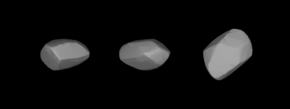
Summary
Atala (minor planet designation: 152 Atala) is a large main belt asteroid that was discovered by brothers Paul Henry and Prosper Henry on 2 November 1875, but the discovery was credited to Paul. It is a type D asteroid, meaning that it is composed of carbon, organic rich silicates and possibly water ice.
 A three-dimensional model of 152 Atala based on its light curve. | |
| Discovery[1] | |
|---|---|
| Discovered by | P. P. Henry |
| Discovery date | 2 November 1875 |
| Designations | |
| (152) Atala | |
| Pronunciation | /əˈtɑːlə/ French: [atala] |
Named after | Atala |
| A875 VB | |
| Main belt | |
| Orbital characteristics[2][3] | |
| Epoch 31 July 2016 (JD 2457600.5) | |
| Uncertainty parameter 0 | |
| Observation arc | 130.69 yr (47735 d) |
| Aphelion | 3.3855 AU (506.46 Gm) |
| Perihelion | 2.8984 AU (433.59 Gm) |
| 3.1420 AU (470.04 Gm) | |
| Eccentricity | 0.077507 |
| 5.57 yr (2034.2 d) | |
| 52.593° | |
| 0° 10m 37.092s / day | |
| Inclination | 12.114° |
| 39.945° | |
| 59.807° | |
| Earth MOID | 1.93567 AU (289.572 Gm) |
| Jupiter MOID | 1.85235 AU (277.108 Gm) |
| TJupiter | 3.171 |
| Physical characteristics | |
| Dimensions | 65 ± 8 km[4] 71–122 km[5] |
| Mass | (5.43 ± 1.24) × 1018 kg[6] |
| 6.246 h (0.2603 d) | |
| 5.28-6.25 hours | |
| 0.054 | |
| D[7] | |
| 8.33 | |
The asteroid is named for the eponymous heroine of the 1801 novella Atala by François-René de Chateaubriand.[8] The Henry brothers also named the last of their discoveries, 186 Celuta, after another Chateaubriand heroine.[9] Both Atala and Céluta are American Indian fictional characters.[10]
An occultation of a star by Atala was observed from Japan on 11 March 1994. Subsequent occultations have been observed as recently as 2006.[citation needed]
Photometric of this asteroid made in 1981 gave a light curve with a period of 5.282 ± 0.004 hours with a brightness variation of 0.50 in magnitude.[11]
References edit
- ^ Hardard's Numbered MPs
- ^ "The Asteroid Orbital Elements Database". astorb. Lowell Observatory.
- ^ Yeomans, Donald K., "152 Atala", JPL Small-Body Database Browser, NASA Jet Propulsion Laboratory, retrieved 12 May 2016.
- ^ Ďurech, Josef; Kaasalainen, Mikko; Herald, David; Dunham, David; Timerson, Brad; Hanuš, Josef; et al. (2011). "Combining asteroid models derived by lightcurve inversion with asteroidal occultation silhouettes" (PDF). Icarus. 214 (2): 652–670. arXiv:1104.4227. Bibcode:2011Icar..214..652D. doi:10.1016/j.icarus.2011.03.016. Archived from the original (PDF) on 3 March 2016. Retrieved 26 January 2012.
- ^ Asterodoccultation.com Archived 2006-10-10 at the Wayback Machine
- ^ Carry, B. (December 2012), "Density of asteroids", Planetary and Space Science, vol. 73, pp. 98–118, arXiv:1203.4336, Bibcode:2012P&SS...73...98C, doi:10.1016/j.pss.2012.03.009. See Table 1.
- ^ SPIFF LCSUMPUB
- ^ Schmadel, Lutz D.; International Astronomical Union (2003). Dictionary of minor planet names. Berlin; New York: Springer-Verlag. p. 29. ISBN 978-3-540-00238-3.
- ^ Schmadel, Lutz D.; International Astronomical Union (2012). Dictionary of minor planet names (6th ed.). Berlin; New York: Springer-Verlag. p. 29. ISBN 9783642297182. Retrieved 4 April 2014.
- ^ Chateaubriand, François-René (1801). Atala.; Chateaubriand, François-René (1802). René.
- ^ Schober, H. J. (July 1983), "The large C-type asteroids 146 Lucina and 410 Chloris, and the small S-type asteroids 152 Atala and 631 Philippina - Rotation periods and lightcurves", Astronomy and Astrophysics Supplement Series, 53: 71–75, Bibcode:1983A&AS...53...71S.
External links edit
- Occultation of TYC 5558-01048-1 by (152) Atala on 2006 May 7 UT
- (152) Atala near opposition 5 July 2007 (2.38AU from Earth)
- 152 Atala at AstDyS-2, Asteroids—Dynamic Site
- Ephemeris · Observation prediction · Orbital info · Proper elements · Observational info
- 152 Atala at the JPL Small-Body Database


